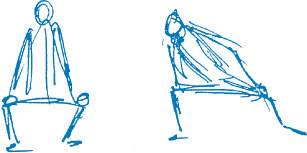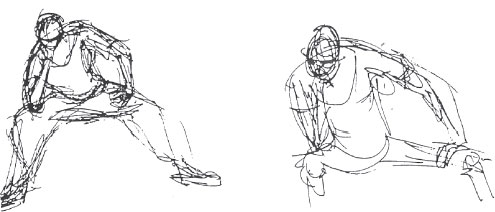Sometimes I come on pretty heavy with a subtle or even questionable suggestion in our evening class on how to capture a pose or the meaning of a gesture. Occasionally I can’t pull it off myself, and I’m embarrassed and the student is frustrated. Sometimes I explain before I start that “I may not be able to draw this, but it could be that…this is what is happening,” and then I make a sketch. My hope is that the “it could be that….” will stick in the mind and not the success or failure of my sketch. “Could be” leaves the path open for unlimited possibilities.
If we are relatively consistent in achieving an acceptable result, we may become complacent and stop growing. “Could be” leaves an open-endedness that may lead to great drawing, rather than merely good drawing. Look at some of the great Disney feature cartoons. You’ll spot the greats, as opposed to the goods, and especially as opposed to the get-by-ers. Some of the get-by-ers may eventually stretch their talents and become goods or perhaps greats — some of them will be satisfied to stay on the get-by plateau. So if you sometimes can’t see the extra possibilities in the model or in your mind, don’t stop searching. You want to be a better actor (storyteller) than a model. Maybe the model is just a “good” model and you want to expand your drawing ability to “great.” The extra “punch” (could be that…) will have to come from within you. Complacency, fear of failure, or self-satisfaction will keep you from even trying. I love to pick on the good artists because they are so close to breaking through to greatness. Maybe just a little “could be” here and a little “could be” there will do the trick.
Let’s consider some of the “could bes” that might transport a good drawing into a great drawing. We’ll have to do it without the model here. But with or without a model, “could bes ” are a legitimate and worthwhile pursuit.

In this first example the artist seems to have gotten the gist of the pose. But when (and if) you consider where the figure started from and the extent to which it has gone (see illustration at right), it could be that his head and right hand have gone past the right elbow. If the figure is looking at something it certainly gets the look out into the clear. It could be that he has leaned over far enough to straighten out his left arm a little more, making it look like it pushes everything into the look. It could be that since the right lower leg is more vertical; that knee will be higher than the other one. If you’re into negative shapes, and you should be, the opening enclosed by the left arm being elongated will help the lean. Negative shapes also squash and stretch. And it could be that if the left hand were wrapped over the leg in a pushing attitude it would compliment the whole action.
In the next sketch the model was clutching a box that had just come from her boyfriend. She was in the process of opening it. The artist seems to have chosen a “could be” that she was clutching the box eagerly as if it contained something precious (a good concept). In searching for another “could be,” I pictured her wrestling with a huge box that she could hardly get her right arm around (later to open it finding only a small gift). Actually my box is smaller than the artist’s, but it seems larger because of the way it’s held.

Notice the angles of the forearms in the artist’s drawing are almost parallel, which is rather static. I have a theory about angles that I will explain briefly. Simply put, two parallel lines are static.
![]()
Angle one of the lines and it sets up a movement.
![]()
It can produce domino effect
![]()
![]()
depending on how it is used in a drawing. In the artist’s drawing, the static effect is the result of the right arm clutching the box and the left arm (hand) pulling up on the box lid, causing them both to do the same thing (no opposition). In my sketch I have the two arms working against each other, setting up a little tug-of-war action. The angles, instead of
![]()
which are static, have two sets of kicking-up angles — the upper arms
![]()
and the lower arms.
![]()
Of course it could be that she had gotten her left elbow up into a pulling position, while pushing down with the other hand, see 1. Or she could have positioned her right thumb on top of the box to oppose the pull of her left arm, as in 2. Or it could be that she was so eager to get into the box, she just sort of tries to crawl into it, as in 3.

In this last example, the model was engrossed with her shoe lacing. The artist’s conception was not a fully congruent depiction of a figure interested in what it was doing. The flow of attention somehow gets interrupted. In my sketch I angled the back in a way that would feature her stretched neck. I angled, even slightly distorted the head into a more intense look at what she was interested in, and stretched the shoulder and arms more to direct the attention downward.

The point being that all characters should be really interested in what they are doing, inspiring the viewers or audience to be interested too. Perhaps thinking “it could be that…” will help you to search out the best way to put over the story point and to get all the elements in focus. And incidentally, don’t shy away from this kind of investigation, thinking that the picture deadlines force you to put quality on the back burner. That’s one of the reasons for your continued study: to be able to arrive at a more desirable drawing in less time. Knowing where to put a line should take a lot less time than not knowing where to put it. So if you figure it’s going to take sixty or a hundred hours of intensive (but enjoyable — if you like drawing) study to get to that comfortable position — start counting.
I apologize for the ponderous text, but I don’t know of another way to show the thought process in arriving at these things.

